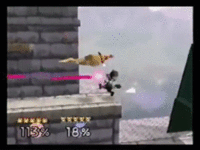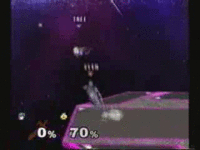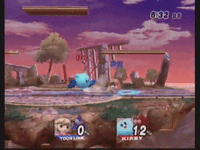Combo: Difference between revisions
No edit summary |
Blackbrass (talk | contribs) mNo edit summary |
||
| Line 11: | Line 11: | ||
*Any sequence of attacks that cannot be DI'd out of if performed perfectly. | *Any sequence of attacks that cannot be DI'd out of if performed perfectly. | ||
*Any sequence of attacks that prevent the opponent from landing (possibly by tech) or ledge-grabbing. | *Any sequence of attacks that prevent the opponent from landing (possibly by tech) or ledge-grabbing. | ||
*Any attack that sends an opponent into a [[stage hazard]] that then leaves them | *Any attack that sends an opponent into a [[stage hazard]] that then leaves them vulnerable to other attacks, such as knocking an opponent into a tornado on [[Hyrule Castle]] in ''Smash 64'', then jumping above the tornado and using a [[meteor smash]] to knock the opponent back down into the tornado after they're launched up to rack damage, or using an aerial to KO. | ||
*Any sequence of attacks performed by two doubles teammates on an opponent to deal extra damage (known as a team combo). | *Any sequence of attacks performed by two doubles teammates on an opponent to deal extra damage (known as a team combo). | ||
Revision as of 15:48, May 7, 2015
A combo is a sequence of attacks that is guaranteed (or very likely) to occur if the first attack hits the enemy. The exact definition of a combo may change from player to player. Some definitions may include:
- A single attack that consists of multiple hits that can string into each other (see natural combo).
- Any sequence of attacks that keeps the opponent in hitstun. These are commonly known as "true combos".
- Any sequence of attacks that counts as a combo according to the combo counter (which allows for one consecutive frame of non-hitstun).
- Any sequence of attacks that is very hard to DI (or in certain cases, tech) out of.
- Any sequence of attacks that cannot be DI'd out of if performed perfectly.
- Any sequence of attacks that prevent the opponent from landing (possibly by tech) or ledge-grabbing.
- Any attack that sends an opponent into a stage hazard that then leaves them vulnerable to other attacks, such as knocking an opponent into a tornado on Hyrule Castle in Smash 64, then jumping above the tornado and using a meteor smash to knock the opponent back down into the tornado after they're launched up to rack damage, or using an aerial to KO.
- Any sequence of attacks performed by two doubles teammates on an opponent to deal extra damage (known as a team combo).
Combos are used to quickly rack up damage on opponents. In Super Smash Bros. 64 and Super Smash Bros. Melee, true combos are very commonly used at low to mid percents due to the long periods of hitstun that leave the opponent vulnerable to attacks. Inescapable strings of attacks in these games started at low percents can easily rack up over 50% of damage, and in Smash 64, every character can perform a guaranteed zero-to-death combo. In Super Smash Bros. Brawl, however, the ability of characters to act during hitstun after a short period of time means that most combos can escaped out of at higher launch speeds. As a result, true combos in Brawl generally work at only very low percents with moves that deal very low base knockback. In Super Smash Bros. 4, the ability to air dodge out of hitstun is removed, making combos more common. However, since most moves have increased base knockback, they are neither as extensive nor as varied as the 64 and Melee combos.


